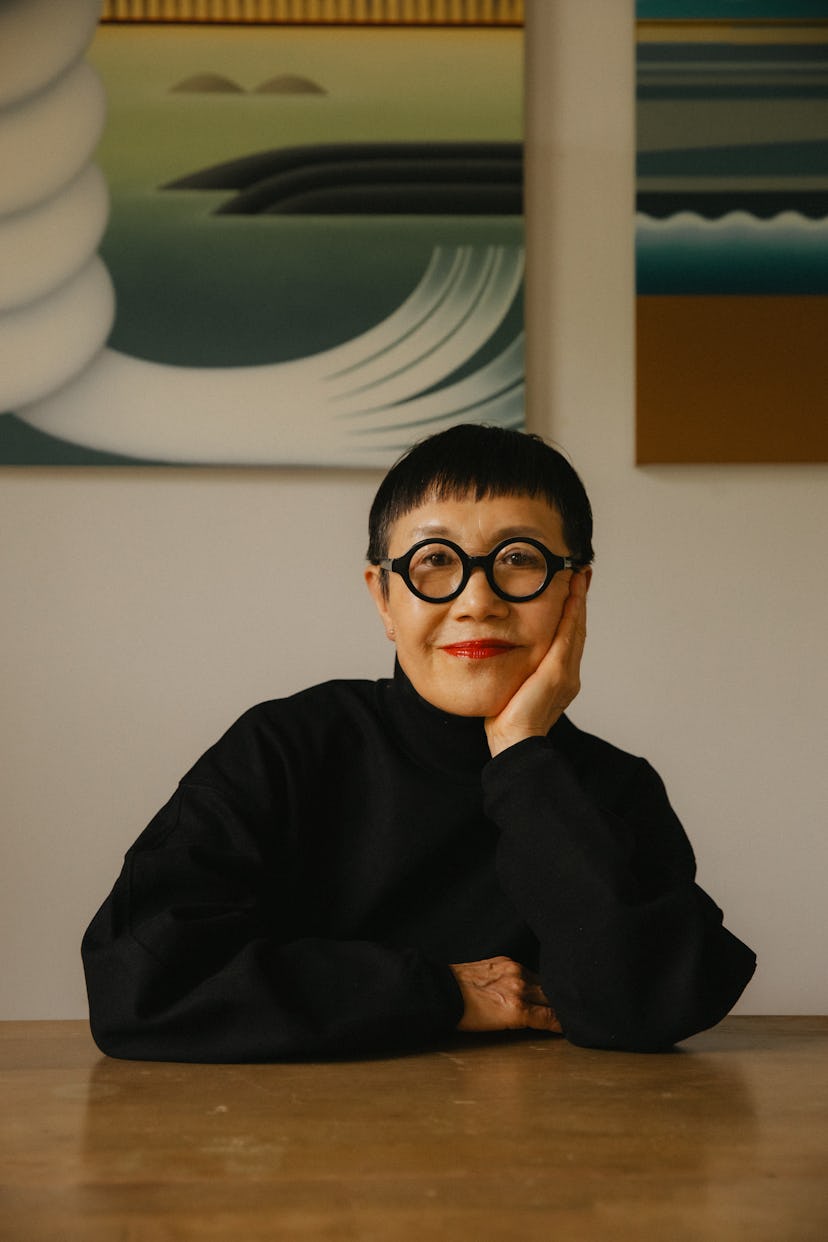The “Accidental Artist” Takako Yamaguchi Is Reinventing Modernism
The painter’s first institutional solo show, at MOCA in Los Angeles, is long overdue.

Artist Takako Yamaguchi and her partner, Tom Jimmerson, have lived and worked in the same rent-controlled apartment, in one of those low-slung bungalow complexes that characterize L.A., since 1978; in 1993, the couple nabbed the unit across the hall to use as Yamaguchi’s studio. The space’s modest fixtures—wall-to-wall carpeting; a couple of nails for hanging straight edges and rulers; yellowing reference notes on prep tables—suggest that little has changed since Yamaguchi, who is now 72, moved in. Here, Yamaguchi spends her days, years, and decades, painting extraordinary self-portraits, landscapes, and abstractions while half-watching old Japanese detective shows on her laptop. She takes few breaks from her work—mostly to attend the openings of artist friends, or to take a quasi-annual trip to see her parents in rural Okayama, Japan, where she was born. If mastery requires 10,000 hours, what can one expect from more than 40 years of singular commitment?
Takako Yamaguchi, Untitled, 2025
Her monkish dedication might suggest that the painter always felt a strong creative calling; however, Yamaguchi’s moniker for herself is the “accidental artist.” She moved to the U.S. in the 1970s to attend Bates College in Lewiston, Maine. When she landed, she enrolled in the school’s fledgling studio program because her English wasn’t perfect, and she didn’t want to have to submit term papers. Yamaguchi was able to channel her perfectionist energy in those early studio classes. With help from a professor, she eventually landed a spot at UC Santa Barbara. Her MFA brought Yamaguchi to the West Coast for good in ’78, but her brief time in Maine explains how the artist moves through the world: by doubling down on her instincts.
Takako Yamaguchi, Plenum, 2024
At the beginning of her career, it was hard to categorize Yamaguchi’s work. Sure, it challenged assumptions around femininity and craft, but you couldn’t say it was Pattern and Decoration. The messaging wasn’t as straightforward as Cindy Sherman’s self-portraits or Robert Mapplethorpe’s political bodies. There were sometimes figures—and they held a charge, even if you couldn’t figure out why. Today, it is perhaps easier to historicize Yamaguchi with ’90s painting heroes like Peter Doig, Chris Ofili, or Laura Owens. But the fit, even among the outliers, still isn’t exact. When describing her first decades, the artist is almost apologetic about her youthful choices. “When I was first picking and choosing subjects, poking around, the process was whimsical, even irresponsible,” she says. “I picked out subjects that I wasn’t sure I was committed to.”
If there was a theme in the subjects Yamaguchi has tackled over the decades—from her Smoking Ladies series (Cecil Beaton-inflected, Jean Rhys-worthy layabouts in Art Nouveau environs) to her vibrating, Agnes Martin-like abstractions (photorealism and homemade sculptures, a perfect takedown of both minimalism and Op Art)—you might say Yamaguchi is preoccupied with beauty and all the routes you can take to arrive at it. This means she can leap from Mexican muralism to Japanese Nihonga to the High Renaissance and back again without wondering if she’s made a wrong turn. “Genre gives you some very interesting problems to work on,” she says. “You decide which part of history or tradition you want to invoke in your own work. I’m not a naturalist or a spiritualist, but I can love a seascape.”
Takako Yamaguchi, Victoria and Whiskey, 1995
The painter is referring to her recent Seascape series, a continuum of 25 landscape canvases, all with the same horizon line. Despite having the same baseline composition, each painting is a variation on waves. The ones crashing in her images recall not only her native Japan, her Santa Monica hometown, and the craggy shores of Maine, but particular works from earlier in her career, like the otherworldly 1990s Innocent Bystander paintings. Twelve of those seascapes are the subject of Yamaguchi’s show at MOCA L.A. curated by Anna Katz, which runs through January 4, 2026.
Takako Yamaguchi, Procession, 2024
This presentation comes on the heels of the 2024 Whitney Biennial, where Yamaguchi showed five seascapes. It should be noted that Yamaguchi’s hometown biennial, The Hammer’s Made in L.A., has yet to feature her—a small crime. But the even larger one is that the first article published on Yamaguchi’s work was about her runaway spring 2024 auction records. The lack of scholarly writing about Yamaguchi’s work makes Katz’s exhibition catalogue feel especially important. It includes foundational essays and chronologizes all of Yamaguchi’s series to date.
Mock-ups of the book are on Yamaguchi’s table. The abundance of paint in the catalogue tell the story of her life. Yamaguchi’s studio, on the other hand, speaks to a different narrative: there is not a drop to be found on the floor or anywhere else. The studio’s uncanny cleanliness furthers the illusion that Yamauchi’s paintings insinuate—that they are born of an immaculate conception and not tied to any specific moment. Yamaguchi describes this as the work’s untimeliness. “Whatever I’m trying to say is always a little bit out-of-step with taste,” she says. “This is barely legible at the time of its enunciation, but the reward is that the message becomes more meaningful with the passage of time.”
No series distills Yamaguchi’s intimate relationship with time better than her recent self-portraits, which feature her own torso in favorite vintage looks. Yamaguchi conjures the detail of the fabrics as carefully as she does the signs of age in her décollatage.
Takako Yamaguchi, Untitled (Crochet Top), 2012-2017
Museums have responded to Yamaguchi’s belated discovery, and private collectors are racing to beat them. Group shows and offers are multiplying, but the dramatic spike in attention hasn’t penetrated the studio yet. As always, Yamaguchi remains cheerfully focused on her daily routine and her detective soap operas. “I still have so many ideas coming,” the artist says. “I sometimes wonder if I’ll have time to get them all down.”